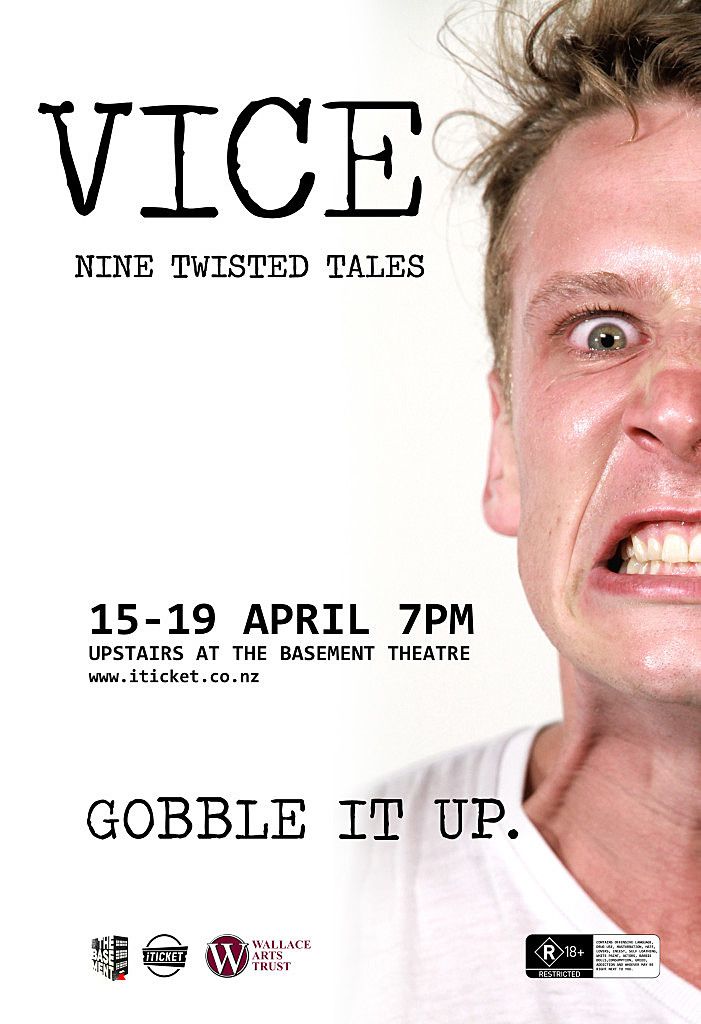Review: Vice
Vice sets out to challenge audience perceptions, but it seems more concerned with the way it's perceived than saying or questioning anything.
Before we enter the theatre, a man wearing a suit and a black sock over his head takes our tickets. I’m not certain how this pre-show element is in keeping with the themes of the show. His ‘facelessness’ rings dissonant to me given the shows apparent goal of humanising the inhuman. Maybe it’s just supposed to be shocking.
The theatre itself has been painted white, and set designer John Kaminski has also plastered walls on the audience half of the room with various advertising leaflets. I don’t understand the flyers, but the white paint looks nice. The obvious reading is some kind of mental asylum. Rachel Marlow, whose minimal design shifts subtly on its harsh white canvas throughout, lights the piece. It’s centrepiece are large, unadorned and dimly glowing bulbs which hang over the action, their volatile filaments occasionally flaring up or flickering toward darkeness. It’s a nice image, which pairs excellently with sound design (Sam Mence and Amber Malloy) to support and mirror the action happening on stage beautifully. The seven characters who will later perform for us are already on stage when we enter. There’s a beat where everyone’s twitching and fidgeting and looking very uncomfortable, then a jolt of electricity and we launch into the first of the seven individual pieces which make up Vice.
Tom Sainsbury’s Gareth introduces us to a misogynistic porn addict portrayed with almost inhuman warmth by the immensely talented Andrew Ford. Ford’s performance is strongest in those moments where he allows his veneer to crack and we see the self-loathing lurking within this creature who seems aggressively lacking in self-awareness. Though the character in Gareth is probably one of the night’s less repugnant (this in spite of his questionable trackpants and compulsive masturbation), he’s working harder than most to convince us (or himself) that his vice isn’t a vice at all.
Before Ford finishes up Daniel Cresswell bursts forth and takes the stage as Dan Musgrove’s Max, a youtube phenom who claims to revel in masochistic displays of public humiliation. Cresswell’s energy on stage is impressive. I enjoyed the moments of levity in Musgrove’s script, and despite Cresswell’s best efforts to manufacture some kind of crescendo, I felt like it didn’t really go anywhere.
Ben Henson’s Happy Meal (performed by Sam Snedden) was highlight of the evening for me. His story about a man who was sexually abused as a child by his well-intentioned mother ebbs and flows in pace and intensity and is hues with an at times beautiful, dark lyricism. Snedden’s performance was excellent and was married wonderfully to the piece. It’s extremely well realised and flickers, jerks, and laments as its tone seems to reflexively follow the narrative course of a guilty discharge. You can really feel the burden of the man’s vice as it weighs on and pressures him.
In Play, Phoebe Mason portrays an adolescent child to great comic effect. The piece, written by Virginia Frankovich, shows the child at play and the ways in which she’s influenced by the adult world around her, which she doesn’t comprehend. Mason does a wonderful job with the character and really let’s the character’s innocence and shine. Play was probably the funniest piece and was a welcome moment of lightness in the midst of the programme. My only wonder is how the piece fits alongside the others in terms of the themes and ideas of the overall play.
I found Melisa K. Martin’s A Cupboard difficult to follow. The character, played by Lauren Gibson, seemed to be wistfully negotiating her way through some personal crisis of conscience. Gibson plays the character with a nice distractedness as she debates with a wardrobe*.
I found Colin Garlick’s Belle the most distasteful of the pieces presented. Performed with conviction by Amanda Tito, it tells the story of a girl who grows up without a mother and is forced into a cycle of incestuous sexual abuse. Tito does a great job, delivering the troubling narrative while displaying her character’s exterior shell with strength and confidence. In spite of Tito’s fine performance, I found this piece slightly exploitative. I understand that the show called for this type of edgy material, but I question the value in watching a male writer using this type of sexual abuse as a kind of punchline. Does Belle add to the conversation? This is a question worth asking of all material of this sort.
Peter Pipe by Anthony James is the final piece of the night. Jordan Mooney plays Peter, a meth addict. Swinging back and forth between pontificating on the glory of an amphetamine high, and raving at the audience his rationale of why we shouldn’t be judging him. In truth he seems more judgemental than us as he condescends the effect he assumes he’s having and what he assumes we think of him. His vice may be drugs, but in truth, we find him obnoxious because he’s a narcissistic asshole.
Mooney also directed the show and as a complete work it bears strong resemblance to Benjiman Henson’s Confessions, another set of thematically linked monologues. Though where Henson’s characters in Confessions were all too prickly and afraid to interact with each other, Mooney isn’t afraid to let his set of vices quietly judge, applaud, or endure each other’s performance, a direction which works well.
One of the problems with Vice is the way in which it markets itself. By promising an audience something which will “challenge your perceptions of good and bad” or alluding to “a place where all masks and pretentions are stripped away” and “Imperfections become perfections through the eyes of a twisted stranger”, the play sets obstacles for itself to clamber over and in doing so leaves itself devoid of the punch it seems intent on packing. Unsurprisingly, it’s much harder to scare someone after you’ve told them what you’re going to do.
Ironically it’s the show’s pretentions that hurt it most. The characters who make up Vice keep yelling at us about how raw and true they are but it’s all so ostentatious that I have a hard time believing anything they’re saying. It’s telling that for me, perhaps the most honest moment came when some buffoon audience member crossed the stage mid-performance in order to use the toilet. Like the characters who make up the pieces of Vice, the play as a whole is hampered by it’s (lack of) self-perception. Which is not to say Vice doesn’t contain anything of worth. Just that the overall packaging of the show felt a bit deluded.
At one point in Mooney’s monologue he abruptly yells, then adds, “I don’t even know why I just did that.” It’s a telling statement, as we don’t either. Indeed I often wondered what the purpose of the show was. For something which sets out to challenge audience perceptions, it doesn’t really have a lot to say. Characters are merely sent forth and put on display in the hopes of shocking the audience. But shocking for what purpose? Our initial judgements of them are never curbed or altered, because they’re all so prickly that by the end of each piece they’ve just further alienated themselves. The white walls surrounding them confirm what we thought to begin with; they belong in an asylum. They need help.
In all I couldn’t help but find Vice lacking. “I’m scaring you.” snarls Mooney during his performance, but the problem was, he wasn’t. Perhaps a hallmark of living in such a desensitised age, or maybe the end result of a play expecting pathos as a given rather than something which has to be earned.
--
* (SPOILER) On a logistical note, I felt what could have been a nice twist in A Cupboard was spoiled by the cast listing in the programme. I’d consider removing the second actor from it in future seasons.
Vice plays at Basement Theatre from 15 April - 19 April
*
See also:
James Wenley for Theatre Scenes
Nik Smythe for Theatreview


